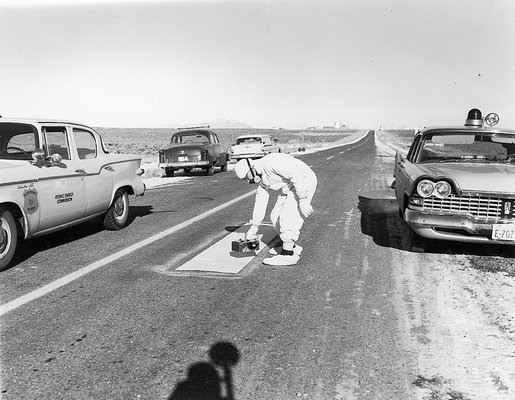
by Cassandra Willyard Thursday, January 5, 2012

A health physicist checks a nearby highway for radiation following the accident. Idaho National Laboratory
Of the hundreds of thousands of caskets buried in Arlington National Cemetery, only one is lined with lead to prevent the body from leaking radiation. It holds the radioactive remains of Richard Leroy McKinley, one of three men killed when a nuclear reactor exploded in the nation’s only fatal nuclear accident.
The disaster occurred one frigid night in 1961, on a remote patch of desert about 65 kilometers east of Idaho Falls at what is now known as Idaho National Laboratory. The reactor, called SL-1, was part of a prototype nuclear plant designed for the military. The Army envisioned using nuclear power to fuel some of its far-flung radar stations, so engineers designed the plant to be easy to operate, easy to transport and easy to assemble.
The reactor, housed inside a large steel silo, was powered by uranium-enriched fuel plates. These plates sustained a nuclear chain reaction, which produced enough heat to turn water into steam, thereby generating electricity. The plant operators could control the reaction by raising or lowering the reactor’s five control rods. When lowered between the plates, the control rods absorbed enough neutrons to stop the chain reaction.
SL-1 began producing electricity in 1958. Over the next two years, the military used the facility to train nuclear personnel. On Dec. 23, 1960, the plant operators shut down the reactor for maintenance. They planned to restart SL-1 on Jan. 4. The task of preparing the reactor to be restarted fell to a three-man night crew, who arrived at 4 p.m. on Jan. 3.
But the procedure didn’t go according to plan. At 9:01 p.m., alarm bells sounded at the station’s firehouse. When the firefighters arrived on the scene, armed with radiation detectors, all appeared to be in order: The operators’ lunch pails sat in the control room, untouched. But as the firefighters approached the stairs leading to the silo, their detectors registered dangerous amounts of radiation, so the men retreated.
Soon after, health physicists arrived with protective clothing, respirators and better radiation detectors. Finally, two men managed to reach the top of the stairs. They saw that the floor was covered in water from the reactor and littered with bits of broken equipment. One of the night workers, Jack Byrnes, was dead, and McKinley was lying on the ground moaning. The third operator, Richard Legg, was nowhere to be seen.
The rescuers reconvened outside to formulate a rescue plan. They knew McKinley likely wouldn’t survive, but they had to attempt a rescue anyway. Four men ran in with a stretcher, carted McKinley to a truck and then transferred him to an ambulance. McKinley died a couple of minutes later. Not knowing exactly what to do with the highly radioactive body, the rescue team asked the ambulance driver to park the vehicle in the desert, away from the highway. There, they swaddled the body in lead blankets so that McKinley could be driven to a more secure location.
Later that night, rescuers found Legg. He had been pinned to the ceiling by a piece of metal, which had flown off the reactor during the explosion. It took several days, a highly trained team and a crane to remove Legg’s body from the silo.
Over the next several months, a team of experts worked to decontaminate the site by disassembling the plant and removing it, piece by piece. But one nagging question remained: What caused the accident?
Investigators figured out that the accident had been the result of a runaway nuclear chain reaction, called a meltdown. To restart the reactor, the operators only needed to lift the control rods 10 centimeters. But a close inspection of scratches on the central control rod revealed that it had been lifted 67 centimeters, nearly 30 centimeters higher than the level likely to trigger a meltdown. But why?
Some speculate that it was an accident: Perhaps the rod became stuck while the men were trying to raise it and had to be yanked. Or perhaps McKinley, who was a new trainee, accidentally raised the rod too far. But all the men were well aware of what could happen if they lifted the rods too high. And the rods were heavy. The highest anyone ever raised one when the investigators simulated a stuck rod was 25 centimeters. Furthermore, investigators later determined that it was Byrnes, not McKinley, who lifted the rod.
A memo written by an employee at the Atomic Energy Commission hints at another possibility: murder-suicide prompted by a love triangle. Although it is true that Byrnes’ marriage was falling apart, no one has ever uncovered evidence of a romantic link between Byrnes’ wife and either of the other two men.
The truth likely died with McKinley, Byrnes and Legg.
© 2008-2021. All rights reserved. Any copying, redistribution or retransmission of any of the contents of this service without the expressed written permission of the American Geosciences Institute is expressly prohibited. Click here for all copyright requests.